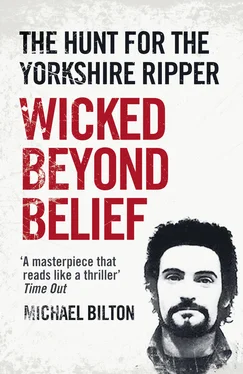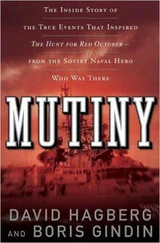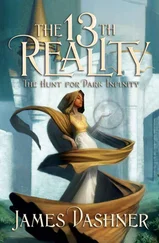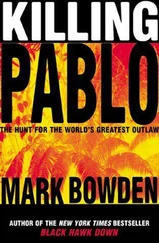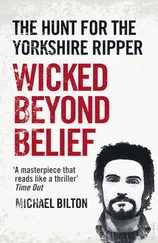Gee arrived at 10 a.m., followed fifteen minutes later by Edward Mitchell, a forensic scientist from the laboratory at Harrogate. By then the standard murder investigation procedures had swung into action. The crime scene was taped off, duckboards laid on the muddy ground, the twenty-strong uniformed task force alerted to conduct a fingertip search; and a black plastic screen about thirty-five feet long was placed in front of the body to veil it from prying eyes. In the distance, officers in uniform began alerting the football teams arriving to play their fixtures that the matches would have to be cancelled while the pitches were minutely examined for clues. When Gee first saw the body it lay on the grass with the face directed towards the left shoulder. The upper part was clad in a long brown, machine-knit woollen cardigan with a zip fastener; the lower part, from the waist downwards, was covered by a short brown imitation suede coat with fur trimming. The feet protruded beyond the end of the coat and there was a sock on the left foot but the right foot was bare. Blood soiled her head, hair and cardigan as well as her neck. Leaves beside the body also had a little blood on them. Beside the body was a tampon. Later laboratory analysis confirmed she was having a period at the time she was killed. The tampon was lightly covered in blood, showing she was nearing the end of her monthly cycle. On the other side of the body, nearer to the pavilion, a trail of blood ran between the body and a handbag lying on leaves nearly four feet off. The flap of the handbag was open and a cosmetics bag and a lipstick were next to it. Beneath the handbag was a mortice key and a 1p coin.
Tyre tracks from a vehicle could clearly be seen between the body and the back of the pavilion in an area of muddy ground clear of trees. The tracks led from the roadway, along the back of the pavilion, and stopped close to the body. Mitchell began to examine the surrounding area, collecting his array of samples and taping the woman’s face. Adhesive tape was stretched across areas of bare skin on her arms, legs and back to pick up fibres, possibly from the killer’s clothing. These fibres would be examined under powerful microscopes and compared with the woman’s clothing. Anything ‘foreign’ would be possible confirmation of Locard’s theory of contact and exchange.
After the body had been photographed in situ, the coat covering the lower part of the body was removed to reveal some bizarre details. Originally the woman had worn two pairs of pants, one pair over her tights, as well as a pair of long light-coloured socks over the tights, presumably to make her footwear more comfortable. Now the woman’s long brown leather boots, with three-inch block heels and two-inch soles, lay along the backs of her legs. As she lay dead on the ground, they had been deliberately placed on her legs, stretching from her thighs down to her calves. When the boots were lifted off, the left leg only was found to have a rolled-down pair of tights bunched up around her left knee. Rolled up into the tights was a pair of red pants and the missing sock from her right foot. There were also fragments of leaves and ground debris tucked into the top of the tights. The woman’s other pants, a small brown nylon pair, were in position over her backside and covering her genitalia.
Once the cardigan was pulled upwards towards the woman’s head, her yellow skirt was found bunched up around her waist, together with a blue underslip. She also wore a yellow jacket beneath which her yellow bra was still fastened. After her temperature was recorded and the body photographed once more, she was turned on her back on to a large white plastic sheet. Her hands were crossed over the lower part of the body, the left wrist overlaying the right. Around her right wrist were four metal bangles. There was a seventeen-jewelled fake-gold watch with a narrow expanding strap on the left wrist, its glass partly obscured by droplets of water inside. It was no longer working and the hands were stopped at the 8.50 position. Time had literally run out for her.
Now Gee, Hoban, Hobson and the others could see there was a large wound at the front of the throat, with soiling of the surrounding skin and the front of the jacket, which was fastened with one button. Beneath her hands in the lower part of the abdomen was a truly shocking wound. A large slashing cut on the left side of the stomach had sliced through the abdominal wall. A number of coils of intestine protruded and these were slightly soiled with blood, matted with leaves and pieces of twig. Still more photographs were taken before the body was wrapped in the plastic sheet, ready to be taken to the mortuary for Gee to carry out a more detailed six-hour examination.
Hobson’s team had meanwhile been examining the contents of the woman’s handbag to see if they could identify her. As the senior investigating officer he quickly needed to know as much about her as possible. The handbag yielded a vital clue: a name and address in Roundhay. From this it transpired that the dead woman was called Irene Richardson; that she had applied for a job as a nanny with a family in Roundhay a week or two previously. The person who advertised for the nanny was then able to provide Irene’s home address, a miserable rooming house in Cowper Street, Chapeltown. Apart from a packet of cigarettes and a box of matches, a few bus tickets and a Yale and mortice key, Irene Richardson’s entire wealth lay in her purse – all 35½ pence of it.
Everyone agreed that what was learned from inquiries over the next few weeks about the lost soul who was Irene Richardson amounted to an immensely sad story. She had been twenty-eight years old, penniless, and fending for herself in very straitened circumstances. Born into a large family called Osborne in the Possilpark area of Glasgow, she had six sisters and three brothers. Their mother was a Roman Catholic and they had a Church of Scotland father. The children were brought up as Protestants. It was said to be a poor, large, but loving family. At primary school Irene was a normal child, though somewhat shy and sensitive. She enjoyed music and loved to laugh. But at Springburn Secondary School she turned into something of a rebel, smoking and playing truant. At some point the entire Osborne clan had settled at various places in England: a brother in Corby, Northamptonshire; a sister at Canvey Island in Essex. Another sister, Helen, worked in the hotel and catering industry in Blackpool, then married a Yorkshireman and later set up home in Sheffield. In 1965, at the age of seventeen, Irene Osborne ran off to London and for the next five years or so completely cut herself off from her family. When her father died, they were unable to contact her and she missed his funeral. Before her teens were out she had two children. Her daughter Lorraine’s father was a man called John Henry Wade. Police believed that Alan, the second child, might have been fathered by someone else, a friend of Irene’s called ‘Dennis’, who was never found. Irene could hardly cope by herself, let alone with two small children. Baby Lorraine was fostered out aged eighteen months in 1968 to a dealer in reproduction antiques and his wife, George and Mary Dwyer, from Croydon. They then adopted her when she was four. Irene’s son Alan was also fostered out.
Subsequently she moved to Blackpool, where her sister Helen was then working. There she met her future husband, George Richardson, a barman turned plasterer, in November 1970, and married him in June the following year. They set up home in Blackpool and had two daughters. Until the summer of 1975 Irene was working at the local Pontins Holiday Camp. Their daughter, also named Irene, was two years old and Irene was expecting another baby, Amanda. She almost certainly suffered from severe postnatal depression, for very soon after the baby was born she suddenly left Blackpool for London without saying where she was going. Mr Richardson reported her missing to the police, but she made contact a few months later. As a result, George Richardson travelled to London and located his wife in South Kensington, working in a hotel. They set up home in Kensington briefly, in an attempt to patch up their marriage. It did not last long. In April 1976 Irene left again without leaving a forwarding address. George Richardson did not see her alive again and their children, too, were subsequently fostered.
Читать дальше
